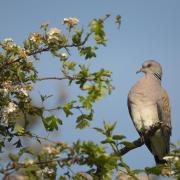Why Kent farmers’ provision of support for farmland birds when food is scarce is vital for their survival
At this time of year I cherish the crisp blue skies above us on frosty mornings. As we go about our autumnal tasks here at Godinton House it’s a delight to see and hear the farmland birds, knowing that our work will support them through winter when the temperature drops and their food sources are sparse.
Farmland bird populations began a period of decline in the 1970s. Species which have particularly suffered include the grey partridge, lapwing, skylark, yellow wagtail and corn bunting. It would be devastating if any of these birds were to disappear from the Kent landscape, in the same way that some of them have disappeared from other parts of the UK.
There is little doubt that modern agricultural techniques were a contributing factor. Now farmers and land managers are playing a critical role in reversing the trend and boosting farmland bird populations.
There are some great examples in Kent of landowners who are leading the way. At Lees Court Estate, near Faversham, an inspirational grey partridge re-introduction project is not only encouraging the wild breeding of grey partridges, but has also created an educational programme for gamekeeping students at Plumpton College and pupils at Sheldwich Primary School.
On the Isle of Sheppey, at the Elmley Nature Reserve – which is owned and run by a farming family – Philip Merricks and his family have created a superb facility renowned for breeding wader birds.
Farmers across Kent are playing their part, many by taking up agri-environment schemes that provide support to deliver environmental land management.
This includes techniques such as putting parts of the farm into conservation measures during winter, which provide food on specially grown seed-rich plots, unharvested cereal strips, uncropped areas and overwintered stubbles for farmland birds. Seed is also put down to help wild birds through ‘the hungry gap.’
Farmers also support farmland birds by laying hedgerows and planting new woodland; this boost insects and fruit sources and provides refuges for wildlife. Hedge cutting is timed to maximise the berry crop available and avoid disturbing the nesting season in March.
Allowing wild flowers to flourish at field boundaries can boost insect numbers too, helping insect-eating birds like grey partridge chicks to survive. Similarly, creating a ‘beetle bank’ across the centre of a field helps increase beetle numbers.
Helping birds find food over the winter is just one of the ways that farmers across Kent take care to support birds as part of the management of their land; others include improving winter cover and enhancing protection from predators.
When the predator is itself a rare species, the best course of action is a subject of some debate. Raptors, or birds of prey, are a prime example. A range of raptor species can be seen in Kent, including hen harriers, marsh harriers, merlins, short-eared owls, common buzzards, and kestrels.
There’s a fine line between promoting healthy populations of our predator species while boosting populations of their prey, and we have yet to strike a balance on this.
Domestic cats and dogs can also disturb our feathered friends, so putting a collar with a bell on your pet can be a solution.
CLA members in Kent are working for a thriving countryside rich in game birds and wildlife. I’ll be looking out for farmland birds this winter and I encourage you to do the same. Kent’s land managers and farmers are working hard to ensure we can all continue to enjoy the markings of a yellowhammer and hear a lapwing’s call. n



























